This pub is closed permanently. Your nearest Wetherspoon pub: The Butter Cross
This Wetherspoon pub bears the name of the ‘first true English surgeon’, who lived in Newark during 1349–70. His work during that period has since earned him the accolade – the ‘first true English surgeon’. It seems that he was particularly adept at treating medieval knights with saddle sores, often the result of long hours spent weighed down by heavy armour, on a horse. By the end of his life, Arderne had achieved the status of Master Surgeon.
Illustrations and text about The Sir John Arderne.
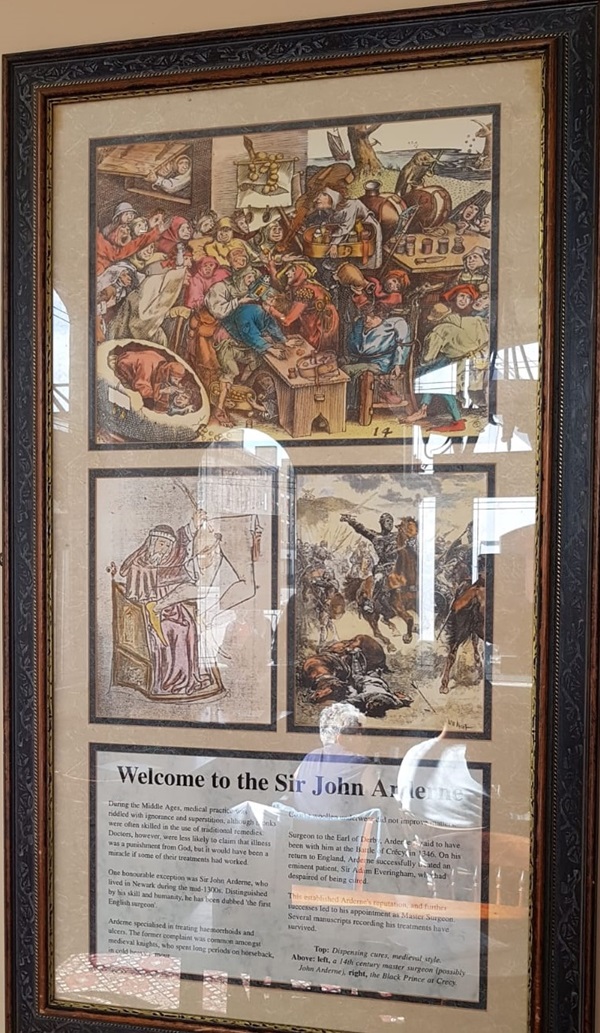
The text reads: During the Middle Ages, medical practice was riddled with ignorance and superstition, although monks were often skilled in the use of traditional remedies. Doctors, however, were less likely to claim that illness was a punishment from God, but it would have been a miracle if some of their treatments had worked.
One honourable exception was Sir John Arderne, who lived in Newark during the mid-1300s. Distinguished by his skill and humanity, he has been dubbed the ‘first English surgeon’.
Arderne specialised in treating haemorrhoids and ulcers. The former complaint was common amongst medieval knights, who spent long periods on horseback, in cold heavy armour.
Coarse woollen underwear did not improve matters.
Surgeon to the Earl of Derby, Arderne is said to have been with him at the Battle of Crecy, in 1346. On his return to England, Arderne successfully treated an eminent patient, Sir Adam Everingham, who had despaired of being cured.
This established Arderne’s reputation, and further successes led to his appointment as Master Surgeon. Several manuscripts recording his treatments have survived.
Top: Dispensing cures, medieval style
Above, left: A 14th century master surgeon (possible John Arderne)
Right: The Black Prince at Crecy.
Illustrations and text about printworks.
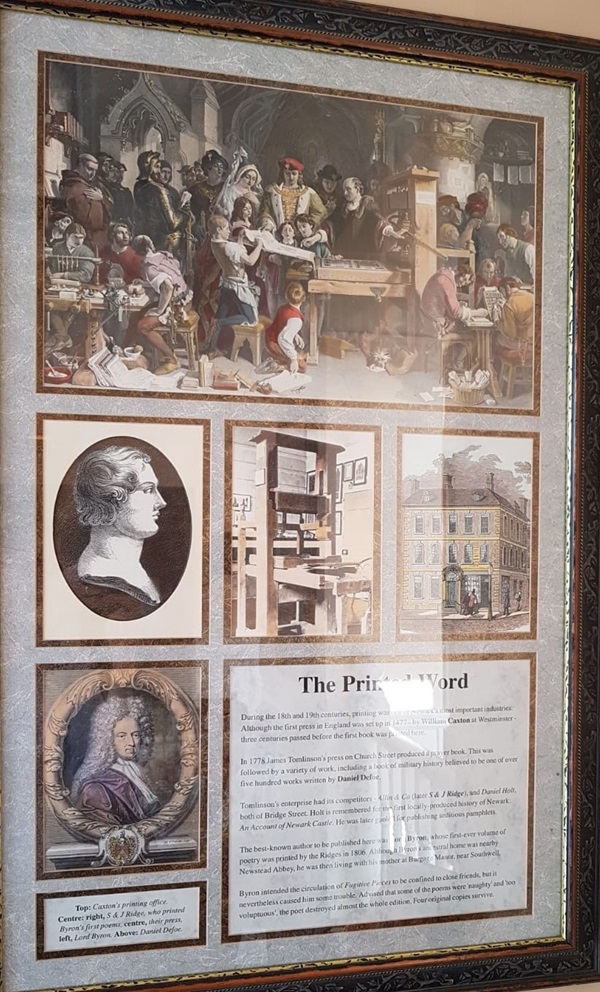
The text reads: During the 18th and 19th centuries, printing was one of Newark’s most important industries. Although the first press in England was set up in 1477 – by William Caxton at Westminster – three centuries passed before the first book was printed here.
In 1778 James Tomlinson’s press on Church Street produced a prayer book. This was followed by a variety of work, including a book of military history believed to be one of over five hundred works written by Daniel Defoe.
Tomlinson’s enterprise had its competitors – Allin & Co (later S & J Ridge) and Daniel Holt, both of Bridge Street. Holt is remembered for the first locally-produced history of Newark: An Account of Newark Castle. He was later gaoled for publishing seditious pamphlets.
The best-known author to be published here was Lord Byron, whose first-ever volume of poetry was printed by the Ridges in 1806. Although Byron’s ancestral home was nearby Newstead Abbey, he was then living with his mother at Burgage Manor, near Southwell.
Byron intended the circulation of Fugitive Pieces to be confined to close friends, but it nevertheless caused him some trouble. Advised that some of the poems were ‘naughty’ and ‘too voluptuous’, the poet destroyed almost the whole edition. Four original copies survive.
Top: Caxton’s printing office
Centre, right: S & J Ridge, who printed Byron’s first poems
Centre: Their press
Left: Lord Byron
Above: Daniel Defoe.
A print and text about John Arderne.
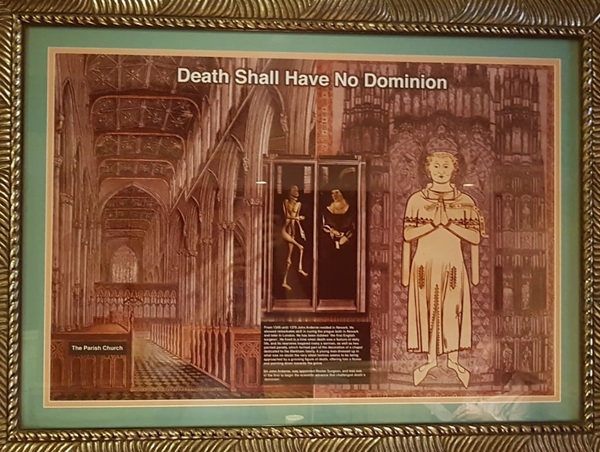
The text reads: From 1349 until 1370 John Arderne resided in Newark. He showed remarkable skill in curing the plague both in Newark and later in London. He has been dubbed ‘the first English surgeon’. He lived in a time when death was a feature of daily life, and its nearness inspired many a sermon, as well as two painted panels, which formed part of the decoration of a chapel dedicated to the Markham family. A young man dressed up in what was no doubt the very latest fashion seems to be being approached by a grinning figure of death, offering him a flower and pointing down towards the grave.
Sir John Arderne, was appointed Master Surgeon, and was one of the first to begin the scientific advance that challenged death’s ‘dominion’.
Prints and text about the Civil War.
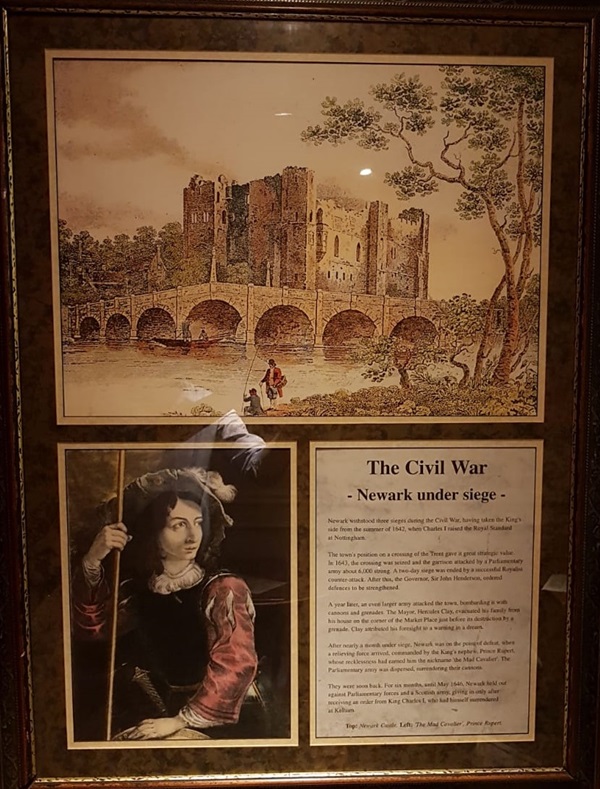
The text reads: Newark withstood three sieges during the Civil War, having taken the King’s side from the summer of 1642, when Charles I raised the Royal Standard at Nottingham.
The town’s position on a crossing of the Trent gave it great strategic value. In 1643, the crossing was seized and the garrison attacked by a Parliamentary army about 6,000 strong. A two-day siege was ended by a successful Royalist counter-attack. After this, the Governor, Sir John Henderson, ordered defences to be strengthened.
A year later, an even larger army attacked the town, bombarding it with cannons and grenades. The Mayor, Hercules Clay, evacuated his family from his house on the corner of the Market Place just before its destruction by a grenade. Clay attributed his foresight to a warning in a dream.
After nearly a month under siege, Newark was on the point of defeat, when a relieving forced arrived, commanded by the King’s nephew, Prince Rupert, whose recklessness had earned him the nickname ‘the Mad Cavalier’. The Parliamentary army was dispersed, surrendering their cannons.
They were soon back. For six months, until May 1646 Newark held out against Parliamentary forces and a Scottish army, giving in only after receiving an order from King Charles I, who had himself surrendered at Kelham.
Top: Newark Castle
Left: The Mad Cavalier, Prince Rupert.
Prints and text about the Beaumond Cross.
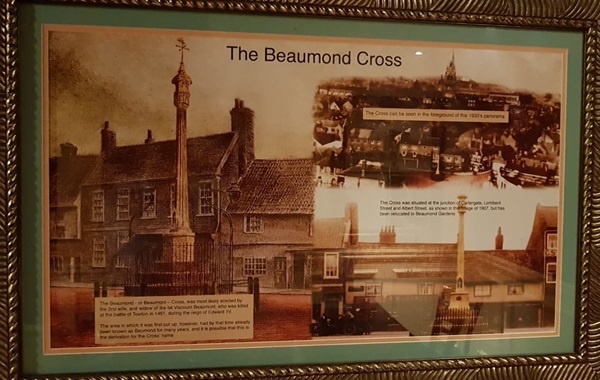
The text reads: The Beaumond – or Beautmont – Cross, was most likely erected by the 2nd wife, and widow of the 1st Viscount Beaumont, who was killed at the Battle of Towton in 1461, during the reign of Edward IV.
The area in which it was first put up, however, had by that time already been known as Beaumond for many years, and it is possible that this is the derivation for the Cross’ name.
Illustrations and text about Lambert Simnel.
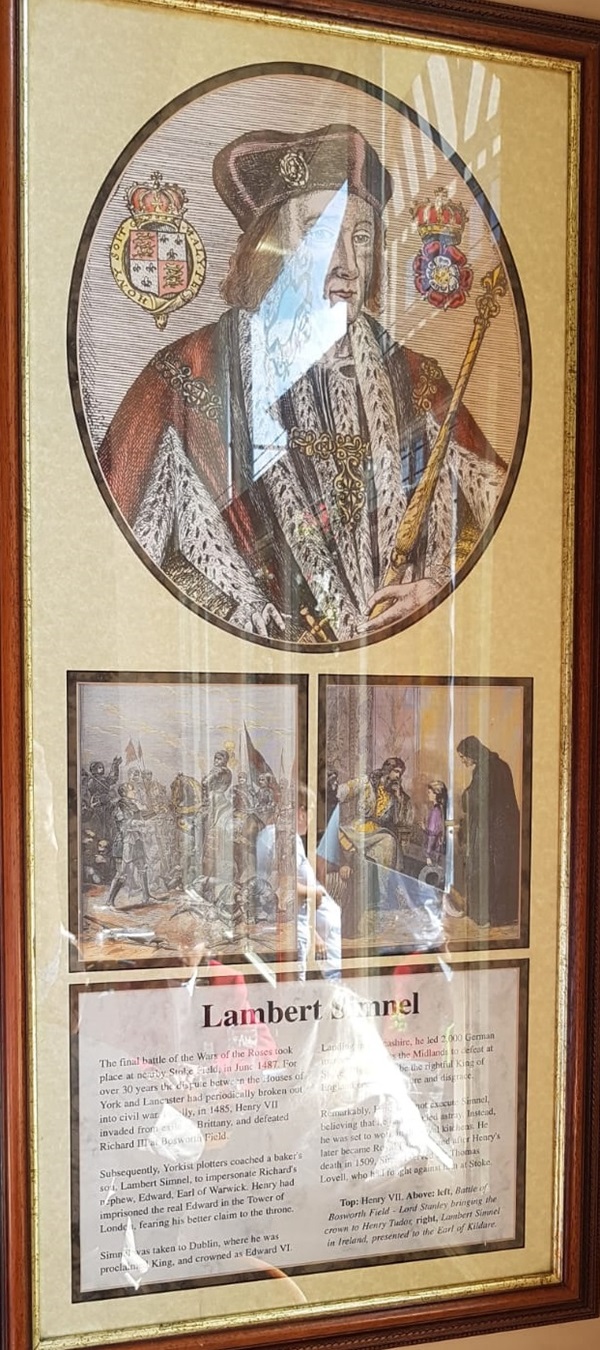
The text reads: The final battle of the Wars of the Roses, took place at nearby Stoke Field, in June 1487. For over 30 years the dispute between the Houses of York and Lancaster had periodically broken out into civil war. Finally, in 1485, Henry VII invaded from exile in Brittany, and defeated Richard III at Bosworth Field.
Subsequently, Yorkist plotters coached a baker’s son, Lambert Simnel, to impersonate Richard’s nephew, Edward, Earl of Warwick. Henry had imprisoned the real Edward in the Tower of London, fearing his better claim to the throne.
Simnel was taken to Dublin, where he was proclaimed King, and crowned as Edward VI.
Landing in Lancashire, he led 2,000 German mercenaries across the Midlands to defeat at Stoke. His claim to be the rightful King of England ended in capture and disgrace.
Remarkably, Henry did not execute Simnel, believing that he had been led astray. Instead, he was set to work in the royal kitchens. He later became Royal Falconer, and after Henry’s death in 1509, Simnel served Sir Thomas Lovell, who had fought against him at Stoke.
Top: Henry VII
Above, left: Battle of Bosworth Field – Lord Stanley bringing the crown to Henry Tudor
Right: Lambert Simnel in Ireland, presented to the Earl of Kildare.
A print and text about Newark Castle.
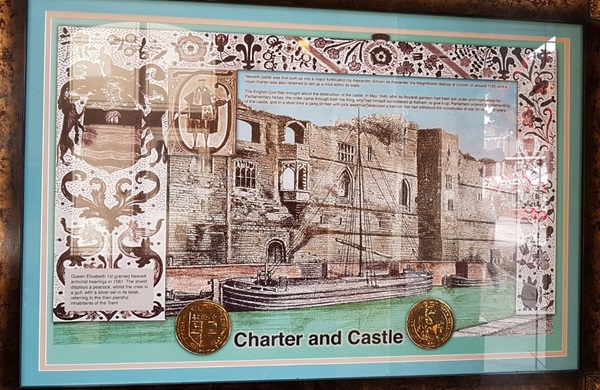
The text reads: Newark Castle was first built up into a major fortification by Alexander (known as Alexander the Magnificent) Bishop of Lincoln, in around 1125, and a royal charter was also obtained to set up a mint within its walls.
The English Civil War brought about the destruction of the castle. In May 1646, after its Royalist garrison had been put under prolonged siege by Parliamentary forces, the order came through from the King, who had himself surrendered at Kelham, to give it up. Parliament ordered the dismantling of the castle, and in a short time a gang of men with pick-axes had destroyed a bastion that had withstood the vicissitudes of war for over 500 years.
Photographs and prints of Market Place.
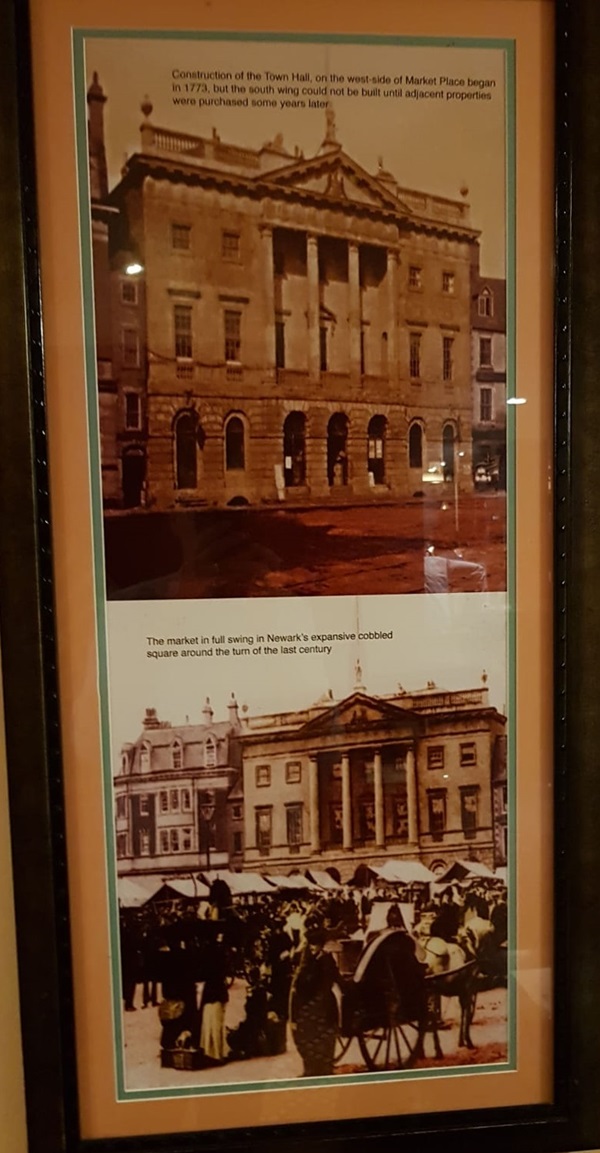
Top: Construction of the Town Hall, on the west-side of Market Place began in 1773, but the south wing could not be built until adjacent properties were purchased some years later.
Bottom: The market in full swing in Newark’s expansive cobbled square around the turn of the last century.
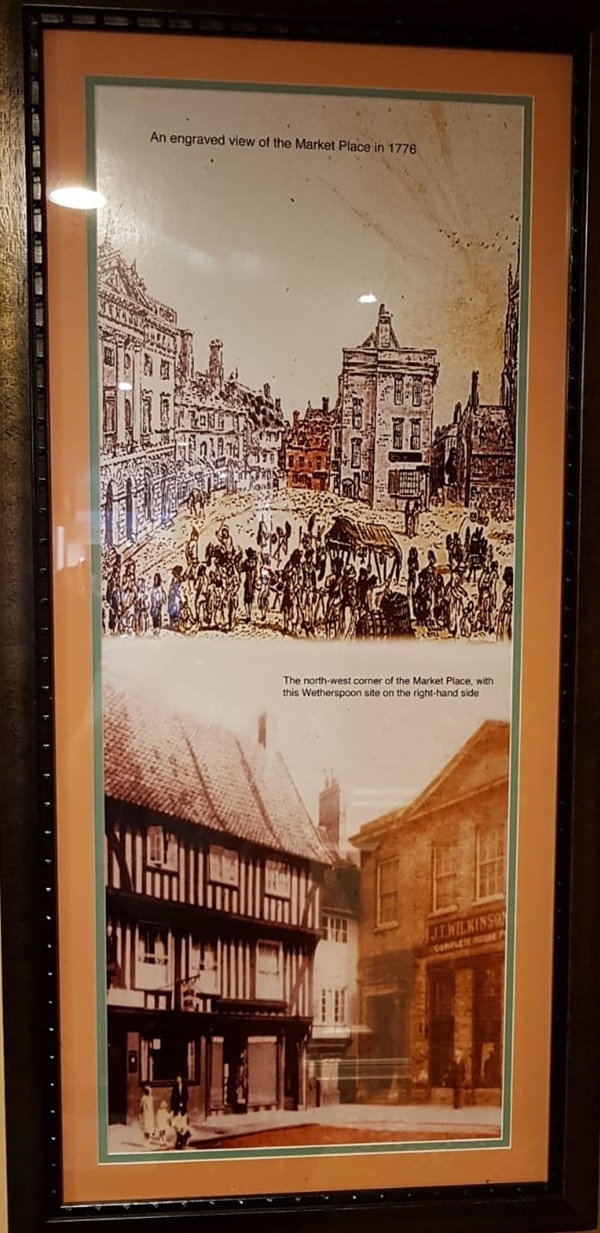
Top: An engraved view of the Market Place in 1776.
Bottom: The north-west corner of the Market Place, with this Wetherspoon site on the right hand-side.
External photograph of the building – main entrance.
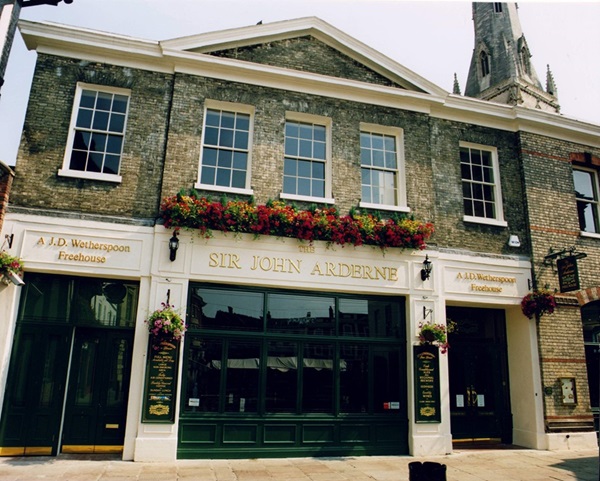
If you have information on the history of this pub, then we’d like you to share it with us. Please e-mail all information to: pubhistories@jdwetherspoon.co.uk